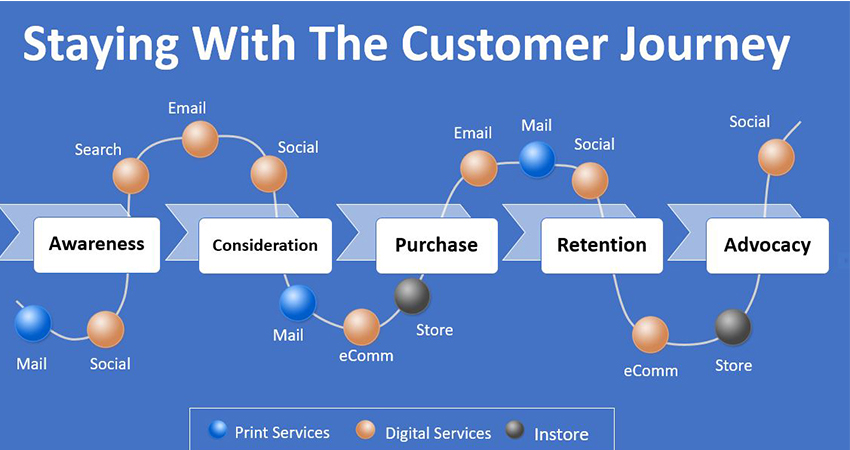If you’re keeping up with ecommerce essentials, you’re using triggered email. Most retailers recognize the value of it but many don’t realize how valuable the associated data is when applied to direct mail and other channels.
The heart of triggered email is website visitor identification. Since most website visitors don’t log in, it’s essential to have technology that identifies visitors by email address. The percentage of cart abandoners linked to an email address varies by service provider, but if it’s less than 60%, you should consider your options for increasing this rate.
Once identified, data can be captured about each shopper’s online activity and used to trigger relevant emails. In addition to cart abandonment, other triggers include items browsed, categories browsed and search terms used. More advanced services offer merchandise triggers and dynamic product recommendations that optimize sales by suggesting products based on what similar shoppers browsed and purchased.
The data captured about each shopper’s interests is incredibly valuable. With all this data linked to the email address, linking the email address to a home address provides a gold mine of data for direct mail. Here are a few ways you can optimize your direct mail with digital channels and data to provide a holistic multichannel experience. These strategies will help you acquire new customers and market more effectively to the ones you already have.
Triggered Postcards: Deliver a full-color postcard to their mailbox in 24-48 hours
Like triggered email, triggered postcards feature carted, browsed or searched-for products and can include dynamic product recommendations based on shopper activity. They’re great for turning prospects who browsed your website into customers, and for engaging customers who don’t subscribe to your email (or subscribers who don’t open them). Audiences can be determined by a combination of website visit factors and customer segmentation.
Digital Hotlines: Use the most profitable hotlines available
Most direct mailers spend a lot of time evaluating potential prospects for their mail stream. Whether exchanging names with another brand or purchasing lists from a co-op, hotlines allow them to find new prospects who are likely to be interested in your products. There are no better new prospects than shoppers who recently browsed products on your website.
Yet this trove of opportunity is often left untapped. If your catalog is about to go out, add recent website visitors not on your current list. You can also test the impact of adding new names with different levels of engagement, such as cart abandoners vs. product browsers. Digital hotlines let you improve recency in ways that historically have not been possible, improving response rates and increasing sales.
Predictive Models: Increase response rates with more effective segmentation
Web visitor and email engagement history can significantly improve your mailing segmentation strategy. Many direct mailers use predictive models to drive mail segmentation and mail/no mail decisioning. In many cases, recency is one of the strongest variables in the model mix. An effective strategy can be to reactivate older buyers based on recent engagement from web visits and/or email opens and clicks. Check with your modeling team to see if they can incorporate web and email engagement data to increase your model’s effectiveness. We’ve found that house file models that use recent online data, have an average response rate lift of 43% and a dollars-per-book lift of 26%.
Mail-to-Visit Link: Measure direct mail’s effect on web traffic
As ecommerce becomes more ubiquitous, it’s increasingly important to know which mailings drive the most website traffic and sales. But it’s often challenging to measure the extent to which direct mail is driving customers to your website. Purchasers are typically asked to enter a catalog code at checkout, but this often doesn’t happen. In addition, this method fails to measure the increased engagement of customers who are driven to your website but don’t make a purchase at that time.
With the right technology in place to identify web visitors and link them to your mail file, no data entry is needed to track when recent catalog recipients visit your website and what they do there. Look for a vendor that can link your mail file to real-time website visitors and pre-populate the catalog source code.
Facebook and Email: Reinforce your direct mail online
The average Facebook user spends more than 30 minutes per day scrolling through their newsfeed. You can easily reinforce your direct mail using Facebook Audiences and vice versa. Matching your mailing list to email addresses enables you to launch a Facebook Audiences campaign in sync with your direct mail.
For example, if you commit to a cost of 50 cents per catalog to get in front of a consumer, the incremental one or two cents to supplement that with a coordinated Facebook ad is a good investment. In addition, a simple email such as “Your Spring Catalog is on the way, keep an eye out for it” will often increase catalog engagement and lead to higher conversions.
You should be using the email address for much more than email!
If you’re identifying website visitors by email address instead of cookies, congratulations! You’re already building the foundation for holistic multichannel marketing.
The device-independent email address has emerged as the ideal identifier for capturing a shopper’s interests from multiple online sources and integrating it under one umbrella. Because it’s typically linked to home addresses, social media accounts, apps, loyalty programs, etc., it’s the ideal connector for integrating shopping data across multiple channels.
To keep up in today’s rapidly changing retail landscape, make sure you’re leveraging your online data not only to strengthen your direct mail, but to integrate your marketing across all marketing channels.
Bob Gaito is CEO of 4Cite

